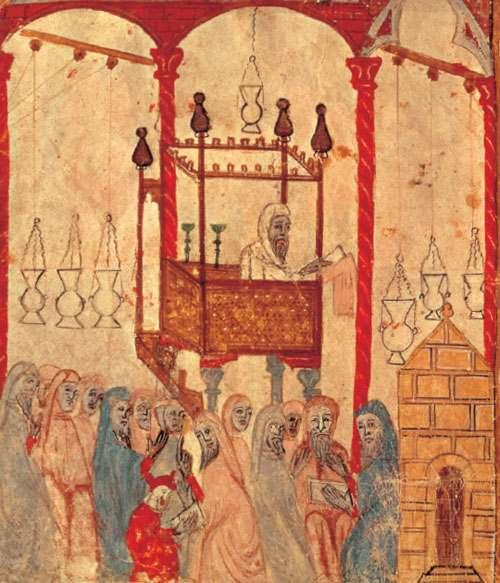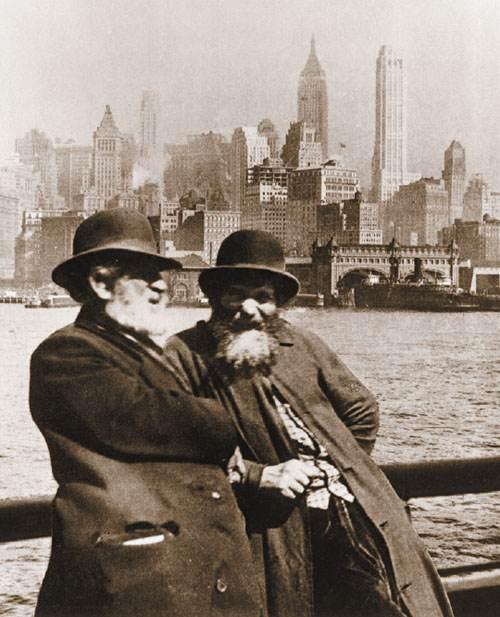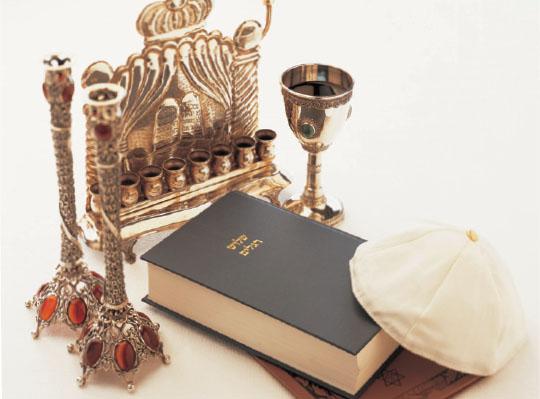Kosher and Traditional Jewish Cooking: Authentic Recipes From a Classic Culinary Heritage: 130 Delicious Dishes Shown in 220 Stunning Photographs (37 page)
Authors: Marlena Spieler

An illumination from a Hebrew manuscript showing a synagogue (c.1350).
For the Jews who settled in Germany and Austria, the age of enlightenment was the Haskalah
(18th–19th century), when the reform movement freed them from the more restrictive bonds of religious adherence and allowed them to enter the secular world of arts, philosophy, science and music. German Jews amassed great knowledge and created a culture of depth and finesse. They became so intertwined with the culture of Germany that when the Holocaust was upon them they could not fathom how it could have happened, because they considered themselves German first and foremost.
Ashkenazi food was the food of a cold climate. Vegetables were pickled in salt and fermented, for instance cabbage became sauerkraut, which was stored to last the winter. Cucumbers were transformed into pickles, piquant treats to enliven the bland fare of winter. Fermented beetroot (beets) became russel, the basis for a traditional borscht. Fish – freshwater, rather than the sea fish enjoyed by the Sephardi Jews – were smoked and salted, as were meats. Because there was often insufficient kosher meat to go round, very small amounts would be bulked out with other ingredients and served as dumplings and pastries, or in casseroles and stews.
Grains and beans were eaten in abundance: healthy, hearty and filling, they were also
pareve
, so they could be mixed with either meat or milk. Often, but most usually for Shabbat or a festival, beans were cooked with meats in a dish known as cholent, which could be eaten when the family returned home from the synagogue.

A group of Ashkenazi Jews sit outside their home in Jerusalem (1885).
Ashkenazi food was often cooked in chicken or goose fat, enriched with golden onions. It was sometimes flavoured with honey, or a mixture of honey and piquant vinegar, to make a tangy sweet and sour sauce.
When potatoes were introduced from the New World, the Ashkenazi Jews adored them and incorporated them into their cuisine with great enthusiasm. Latkes and kugels, soups and dumplings were all prepared from this new and filling vegetable.
The history of the Jews in Britain is long and complex. They first arrived in 1066 and were expelled by Edward I in 1290, a hundred years after the massacre at Clifford Tower of York’s entire Jewish community. In 1655, after negotiations had been held between Manashe ben Israel and Oliver Cromwell, Jews were allowed to return and live in England.
Sephardi Jews then came to settle in England. They came via Holland, bringing with them the flavours and specialities of their native Portugal, which included their favourite dish, battered or crumbed fried fish. This was very likely the origin of Britain’s traditional fish and chips, as the fish was subsequently combined with fried potatoes and eaten by the hungry masses – mostly Jews, often young women who worked in sweat shops in London’s East End.
Today, most of Britain’s Jewish communities live in London with smaller communities scattered around the rest of the country.
The French cuisine shows a strong influence from the Jewish community that settled there. Foie gras, often considered to be French, originated in ancient Egypt and was introduced to France by Jewish immigrants.
The Italian Jewish community (Italkim), which is now very small as a result of the Holocaust and post-World War II emigration, was once grand, influential and active. The Italian cuisine has been influenced by these settlers. To this day,
carciofi alla Giudia
(artichokes in the Jewish manner) is a speciality of the ghetto of Rome, ghetto being a word that originated in Italy to describe an area set aside for Jews.
In the early part of the 20th century there was a wave of immigration to the United States, which influenced the American table a great deal. The most obvious influence was the emergence of the delicatessen – or deli. In places that were home to Jewish communities from Eastern Europe, such as Chicago and Old New York, delis were places where hungry men with no homes of their own could go for a good meal. These men had usually travelled ahead of their wives and children to establish a new life. Lodging in rented rooms and working hard to save enough money to pay for their families to join them, they needed somewhere to eat that was kosher, and that gave them a taste of the land they left behind.
The 20th century saw the end of many of the great Jewish communities – some as old as 2,500 years – and the start of others. Ashkenazim emigrating from Germany, Central Europe and Russia towards the end of the 19th century and the start of the 20th century often packed little by way of possessions, but they did take the traditions of the cuisine that we think of as Jewish: chicken soup and matzo balls, Viennese pastries, rye bread and bagels. The same dishes – familiarly called the food of the Old Country – travelled to Great Britain, Israel, Latin America and the United States with the refugees before, during and after World War II.
In many places, communities have regrouped. In Los Angeles you will find the Jewish community of Iran, which had been in Persia since 600
BCE
(
BC
) and held to their customs and cuisine. In Brooklyn there is a Cochinese synagogue, where Indian Jews cook their spicy delicacies for feasts.
Whether the traditional Jewish table is Sephardi, Ashkenazi, Conservative, Reform (Progressive), Orthodox or Chassidic is not what matters most. The most important factor is that the food it holds reflects both a people’s lives and its culture. It is food for enjoying and for bringing families closer together, for giving reassurance in an ever-changing world and for sharing with old and new friends alike.

Twentieth-century Jewish immigrants await entry into New York.
and
festivals
The Jewish calendar is punctuated by holidays, festivals and observances, shared by the entire community. Personal milestones in the lives of individuals such as Bar or Bat Mitzvahs, weddings and the birth of babies are also celebrated. Each festival has a special significance, and is accompanied by its own songs, stories, admonitions, activities, prayers and, of course, foods.
The Jewish year follows the 354–5 day lunar calendar, as opposed to the 365–6 day solar year, so while each Jewish festival falls on precisely the same date in each year of the Jewish calendar, the dates will differ on a Gregorian calendar. For synchronicity, and also to keep the months in their appropriate season, a 13th month is added to the Jewish calendar every two or three years. In the northern hemisphere, therefore, Rosh Hashanah will always be celebrated between summer and autumn, while Chanukkah always heralds winter and Pesach ushers in the spring.
Jewish holidays always begin at sundown on the day before. The year of celebrations starts around September, with Rosh Hashanah, the Jewish New Year, and progresses through Yom Kippur, the Day of Atonement, which is nine days later. Sukkot, the harvest festival of thanksgiving, follows, ending with Simchat Torah, the festival of the Torah. Around December comes Chanukkah, the festival of lights. Tu b’Shevat, the Holiday of the Trees, comes next, around February, and this in turn is followed by Purim, a festival that could be considered a kind of Jewish Mardi Gras or carnival. Pesach commemorates Israel’s deliverance from Egypt. During the eight-day festival, Jews consume particular foods and drinks, eschewing those that contain leaven. Shavuot celebrates the Giving of the Torah, while Tish b’Av is a day of fasting, when the Destruction of the Temple is mourned.

Jewish holidays commemorate the past and demand tradition and ritual.
Many Jewish communities also observe Yom Hatsmaut, Israeli Independence Day, which is celebrated on 14 May. Yom Ha Shoah, the Holocaust Remembrance Day, is observed shortly after Pesach, honouring the millions who died.
The most important festival and observance of them all is the Sabbath or Shabbat, which comes not once a year, but once a week.
This is the Sabbath, the day of rest. It is the weekly oasis of peace in the sea of hectic life. Even those who are not observant in other ways will often enjoy keeping Shabbat. It is a day for refraining from work, escaping the chaos of the working week, focusing on the spiritual, and enjoying family life. The word
shabbat
means cessation of labour, and it is a time to relax with family and friends.
The origins of Shabbat are related in Genesis, the first book of the Bible, which describes how God created the world in six days and rested on the seventh. In the fourth commandment of the Ten Commandments, it is also decreed that Shabbat is a day of rest that must be kept holy (Exodus 31:17).
Observant Jews do not do any work, handle money, carry loads, light fires, tear paper, watch television or listen to the radio. They also may not cook, which has led to ingenious ways of providing freshly cooked food without infringing the rule.
On the eve of Shabbat a festive meal is served. It begins with the lighting and blessing of the candles before sundown. Further blessings are then said over the challah, and the Kiddush (sanctifying blessing) is said over the wine.
The meal on Friday night includes chicken soup, and a chicken or braised meat. Guests will be invited, and the table set with white linen, flowers and the finest china. The next day’s meal will be simmered in a low oven, as no cooking is allowed on the Sabbath.
